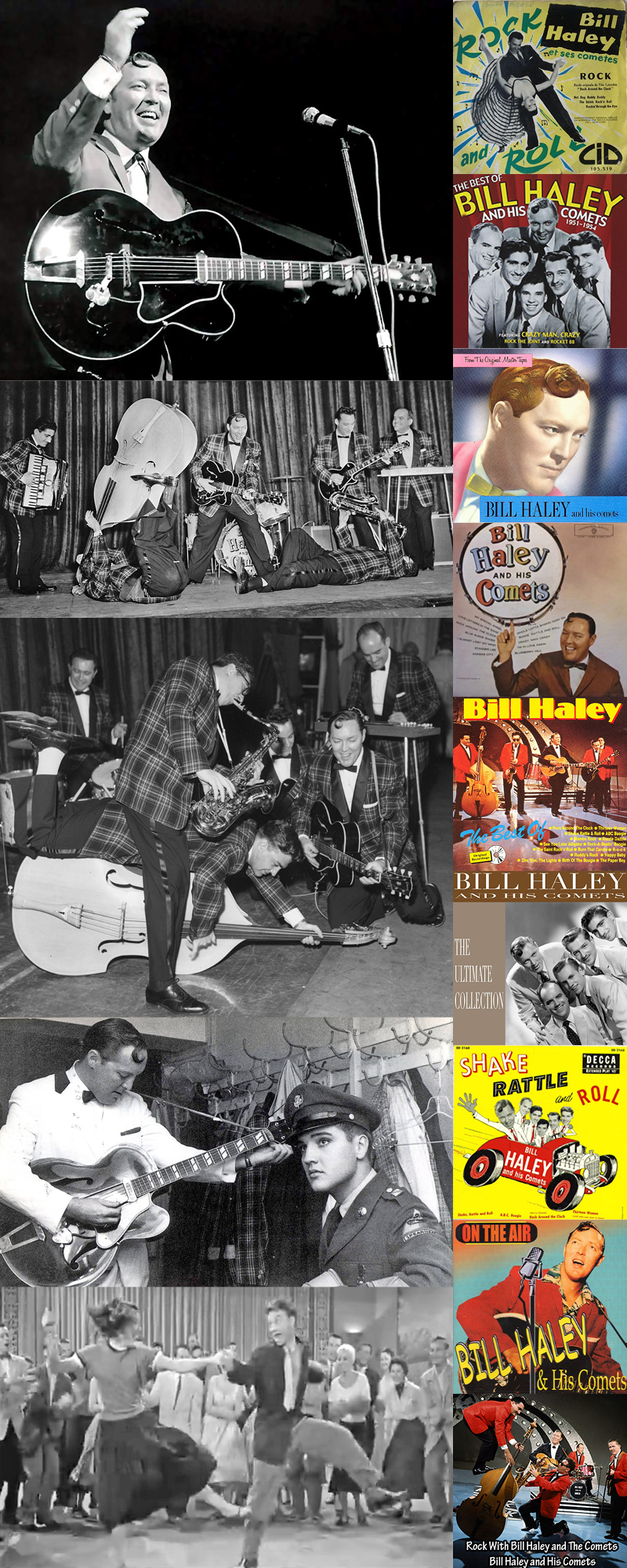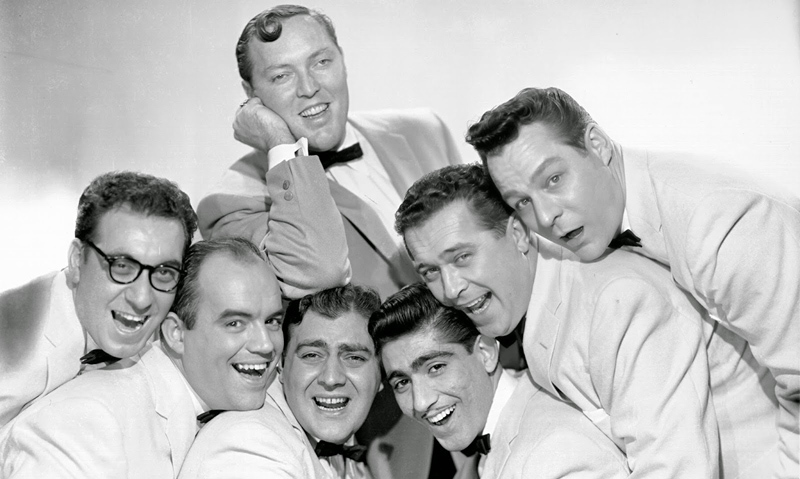… and the Comets

(left column top to bottom) That’s the man, Bill Haley. The real King of Rock ‘n Roll! ; The band with the bassist and the sax player doing their thing. I imagine this horrified the parents of the day; If that guy in the military uniform looks like Elvis Presley, it is. Back stage at Haley’s 1958 European tour in Germany. That bottom photo of teens dancing is from the movie “Rock around the Clock” and represents what really did horrify parents of the day. But they dressed nice and not a tattoo in sight. (right column top to bottom) Loads and loads of albums and 45 RPM singles produced in his fabulous game-changing career.
The other morning, I arrived earlier at the office than I usually do (5am), took an extra-long morning run in down past the Rock ‘N Roll Museum and then logged on for the daily production reports. I took pause of the amazing efforts of my staff, monitoring all the jobs that run overnight, keeping everything on track for the morning shift to come in and pick up where they left off. In sort of a crazy way, it got to thinking about each hour – one o’clock, two o’clock, and it reminded me of that great fun dance tune by Bill Haley and the Comets (perhaps it was my encounter with the Rock Hall earlier). Yep, you know what happens next – I started singing the song in my head, over and over, and then finally sat down at the computer to see what I could dig up. And sure enough, some fun trivia and history on Bill and his famous Cleveland Rock Hall inductee band. So, for my music trivia gang, here you go (I included some early history, as I’m always intrigued where musicians came from, their families and influences – be sure to click on the links to some really great tunes – and special thanks to history-of-rock.com, You Tube and my guys who keep the shop humming all night long.
- Billy Haley and his Comets fused elements of country music, Western Swing, and black R&B to produce some of rock and roll’s earliest hits.
- Bill Haley was born in Highland Park, Michigan on July 6, 1925 to William and Maude Haley. The couple’s second child, Haley had a sister Margaret who was born two years earlier. When Haley was four while having an operation to repair an inner ear ailment the doctor accidental cut an optic nerve. The result was that Haley would never ever see out of his left eye.
- The Haley’s had moved to Detroit from Firebrick, Kentucky, where William Sr. found work in a nearby service station as a mechanic while his wife gave piano lessons in their home for twenty-five cents an hour. Maude Haley, a woman of strong religious convictions, had come to America with her family from Ulverston in Lancastshire, England before the First World War. Later the family moved to Boothwyn, near the town of Chester, Pennsylvania.
- At thirteen Haley received his first guitar. His father taught him to play the basic chords and notes by ear. It was at this time he began his dream of becoming a singing cowboy like the ones he idolized every Saturday afternoon at the movie houses in nearby Marcus Hook or Chester.
- In June of 1940, just before his fifteenth birthday, Haley left school after finishing the eighth grade and went to work bottling water at Bethel Springs. This company sold pure spring water and fruit flavored soft drinks in a three-state area. Here he worked for 35 cents an hour, filling large five-gallon glass bottles with spring water. Only the absolute best of the best were making a living from making music. At 18 he made his first record “Candy Kisses” and for the next four years was a guitarist and singer with country and western bands.
- After time on the road with the Down Homers, Haley returned to his parents’ home in Booth’s Corner in September of 1946. He was ill, disillusioned and so broke he had to walk from the train station in Marcus Hook four miles to Booth’s Corner. His only request to his mother was not to tell anyone he was home, not even his fiancé Dorothy. Bill fell into bed and slept thirty hours. Over the next two weeks Mrs. Haley slowly nursed her itinerant son back to health.
- By the age of 21, Haley felt he wasn’t going to make it big as a cowboy singer and ill left the ‘Downhomers’ and returned to Chester to host a local radio program. At this time, he also married his childhood sweetheart Dorothy Crowe a beautiful part American Indian girl.
- Haley was hired in 1947 as musical director for radio station WPWA.
- It was during this time that he put together a band The Four Aces of Swing that performed on his show.
- In the summer of 1950, through the efforts of Jimmy Myers, Bill Haley and his Saddlemen cut their first records. They were on Ed Wilson’s Keystone label, a small Philadelphia independent publisher. The songs were standard western swing tunes: “Deal Me A Hand” /” Ten Gallon Stetson” and “Susan Van Dusan” /” I’m Not to Blame.” They were the first recordings of the band that would become the nucleus of the world-famous Comets.
- With their new, exciting sound, the name “Saddlemen” no longer seemed appropriate. According to Marshall Lytle, it was Bob Johnson, Program Director at WPWA who first suggested the name Haley’s Comets. “Ya ‘know, with a name like Haley, you guys should call your group the Comets!”
- Just before the Thanksgiving holidays in 1952, Haley’s band changed their name and their image for the last time. The four young musicians, turned their backs on their beloved country/ western music and bravely faced an unknown future as “Bill Haley and His Comets”.
- One example of that change was “Rock the Joint” which sold 75,000 copies. In 1953 he wrote “Crazy Man Crazy” which became the first rock and roll record to make the Billboardpop chart reaching the Top 20.
- On April 1st, 1954, Myers, Gabler and Bill Haley met in Decca’s New York offices. The three men discussed a contract for four records a year, a standard royalty of 5% of sales, $5,000.00 in advance royalties and the understanding that Decca would mail out each release to two thousand disc-jockeys with full support publicity. Support included full page ads in Billboard and Cash Box magazines! With the deal set and signed, the three men shook hands and agreed on a recording date four days after the Essex contract was due to expire.
- It was while at Decca that Haley fell under the influence of Milt Gabler who had produced Louis Jordan. Gabler would convince Haley to change his sound. That change would be evident when on April 12th 1954, at Pythian Temple Studio with the recording of “Rock Around the Clock.” The song that introduced rock & roll to America. “Rock Around the Clock.” The song was a modest hit, until it was used as the title track of “The Blackboard Jungle,” a movie about juvenile delinquents, some 12 months later, and then it exploded.
- His next record a cover of Joe Turner’s “Shake, Rattle and Roll’ was a top ten hit. It was the first rock & roll record to sell a million copies
- The next really big hit came with “See You Later Alligator” which sold a million copies within a month.
- In September 1955 band members Dick Richards, Marshall Lytle and Joey D’Ambrosio went to the Comet’s manager Jim Ferguson and asked for a raise. Turned down, they gave two weeks notice, and went and signed with Capital Records and recorded as the Jodimars. Lytle was replaced by Al Rex,Haley’s original basist from the Saddlemen, D’Ambrosio by Rudy Pompilli and Richards by Ralph Jones.
- In 1957, Haley began touring in Britain as his popularity began fading at home. The first American Rock and Roll star to come to Britain, he was met with large and enthusiastic crowds. The British soon found out what American teenagers already knew. Haley with his spit curl was old (30), overweight and rather mechanical when compared to Little Richard, Jerry Lee Lewis, Gene Vincent and Elvis who were younger and who’s music was more exciting. Bill Haley & His Comets were there first, but now they were part of the “establishment”.
- After 1957 Haley had a few minor hits but spent the remainder of his life touring and playing Rock and Roll Revival shows throughout Europe and the US. In the early morning hours of February 9th, 1981, Bill called two of his sons, Scott and Jack, and had his last known conversations. He died, in his sleep of an apparent heart attack, about 6:30 that morning at his home in Harlingen, Texas.
- Although several members of the Comets became famous, Bill Haley remained the star. With his spit curland the band’s matching plaid dinner jackets and energetic stage behavior, many fans consider them to be as revolutionary in their time as the Beatles were a decade later. Haley and his band were inducted into The Rock and Roll Hall of Fame in 1987.
Oh, What the Heck, Crank Up the Sound!

“Bill Haley was a celestial body that inhabited planet earth. He gave the teenagers something they never had before – their own music!” –Unknown
CLICK – Clip from the movie “Rock Around the Clock” (1955)
CLICK – Bill Haley & The Comets sing one of their biggest hits – Shake Rattle & Roll.
CLICK – Bill Haley & His Comets – See You Later Alligator
CLICK – “Rock-A-Beatin’ Boogie” or “Razzle Dazzle” is a 1952 song composed by Bill Haley and first recorded by The Esquire Boys in 1952. It was recorded by Bill Haley and the Comets on September 22, 1955 and was released in October of 1955 as a single in the U.S. on Decca, backed with “Burn That Candle”. It reached #23 on Billboard, #24 on Cash Box, and #4 on the RU charts in January, 1956. The song was featured in the 1956 movie Rock Around the Clock (Wikipedia).
CLICK – Bill Haley and the Comets sing “Tequila” (live in Belgium, Brussels 1958) at the Royal Flemish Theatre.


